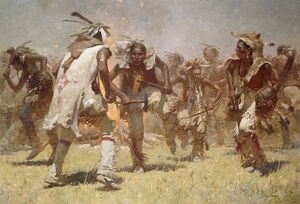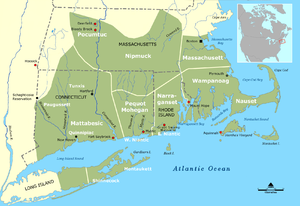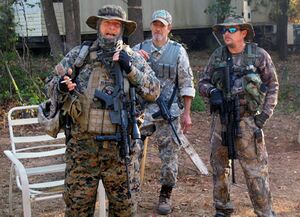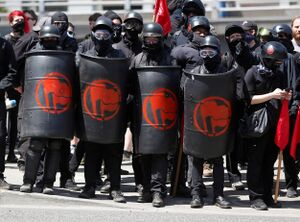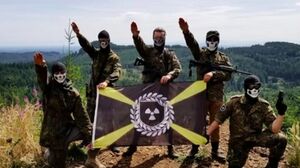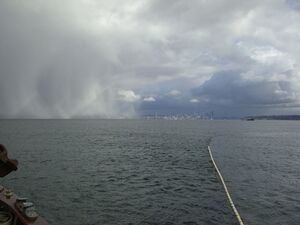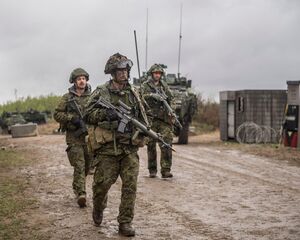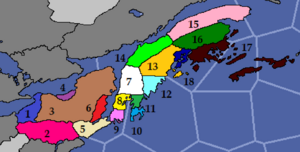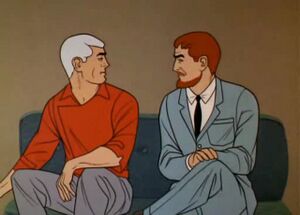Angevinia
This article is incomplete because it is pending further input from participants, or it is a work-in-progress by one author. Please comment on this article's talk page to share your input, comments and questions. Note: To contribute to this article, you may need to seek help from the author(s) of this page. |
Commonwealth of Cydalia Commonwealth a Cydalia (Cydalian) Keenchrei fun Cydalia (Deitsch) Roiaum d'Cydalie (Qadian) Cofhlaiths 'a Cydalia (Scoshun) Ganonsyoni Cydalia (Iroquoian) Cydalia Nutohkemminnit (Algonquian) | |
|---|---|
Motto: An Appeal ta Heaven | |
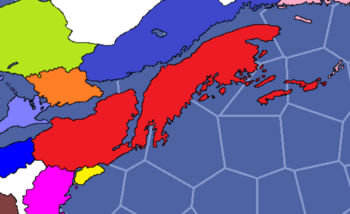 Cydalia (red) in Merica, circa 2319. | |
| Capital | New Hahtland |
| Largest city | Awlbany |
| Official languages | Cydalian English |
| Recognised national languages | Cydalian English Deitsch Qadian Scoshuns |
| Recognised regional languages | Deitsch Qadian Scoshun |
| Ethnic groups | Cydalian (77.1%) Deitsch (7.8%) |
| Demonym(s) | Cydalian |
| Government | Semi-Constitutional Falango-Integralist Monarchy |
• King | Planter Dogood |
• Head of Pahlament | David Zekara |
| Legislature | Pahlament |
| The Elected | |
| The Appointed | |
| History | |
• First New English Colony | November 3rd 1620 |
• American Independence | July 4th 1776/September 3rd 1783 |
• The Great Collapse | April 15th, 2049 |
• Foundation of Cydalia | April 28th 2100 |
• Formation of the Commonwealth | December 31st 2221 - January 1st 2222 |
• Cemented Status | 2260 |
| Population | |
• 2319 estimate | 20,165,201 |
| GDP (nominal) | estimate |
• Total | GDP Not used |
• Per capita | GDP Not used (GDP Not used) |
| Gini | Gini not used Error: Invalid Gini value |
| HDI | 0.937 very high |
| Currency | None (N/A) |
| Time zone | Eastern Standard Time |
| Date format | dd-mm-yy |
| Driving side | right |
| Calling code | +07 |
| Internet TLD | .cy |
Cydalia, officially the Commonwealth of Cydalia or the Cydalian Commonwealth (Cydalian: Commonwealth a Cydalia), is a sovereign nation located in northeastern Merica. Cydalia is bordered by Ronto, Québec, and Canada to the northwest, Newfinlan to the northeast, Federalia and Marval to the south and Erie to the west. In addition, it also borders a section of wildlands that it frequently attempts to bring civilization to. Compared to other Merican nations, Cydalia is a sizeable ## km2 (### sq mi), making it one of the largest nations in Merica, with an estimated 2319 population of 20.1 million. The country's population centres are spread across the coastlines of the nation, but vast tracks of rural and untouched land still remain, alongside ample nature preserves. It is a Semi-Constitutional Falango-Integralist Monarchy with the capital in New Hahtland, while the country's largest city is Awlbany. The main cultural and commercial centre of the nation is widely considered to be Bostyn. The Declaration of the Commonwealth establishes the state as Catholic and absolute, with its sovereignty derived from both God and the military.
Pre-Collapse, what is now Cydalia was inhabited by Native American tribes before being conquered and colonized by mainly British and French settlers. It served as a religious hub for Puritanism, and while known as New England, Cydalia proved instrumental in the American Revolution. America emerged as a heavily New England-influenced nation during it's beginning, and solidified it's power all over what is now Merica through Manifest destiny. During the 1950s and onwards, Cydalia and America both experienced vast cultural shifts and changes - and re-development - and helped America form the American Empire, widely considered to be the most powerful empire on the face of the Earth. Despite this power, the cultural changes would prove to be too much for the American Empire to handle, and that, mixed with climate change, would cause a civil war in the late 2020s and early 2030s, leading to an eventual collapse of society in the 2030s and 2040s. During the Second American Civil War, what is Cydalia widely sided with the unsuccessful Democratic Forces and Antifascist militias, which were quickly wiped out by the defecting American military, the Gilead Compact, and various far-right militias. Despite this, the ruin brought to America proved too much for it to recover in time before the Great Collapse in 2049, in which the world was thrown into chaos by the eruption of the Yellowstone supervolcano at the hands of Kaczynskiist extremists.
After the events of the Great Collapse, the Kingdom of Cydalia was founded after the various towns and cities in what was the Connecticut River Valley allied one another in 2100, and elected Karl Dogood as their first King. Over the following centuries, through diplomacy and warfare, the Cydalians would expand both eastward and westward, conquering the Hudson and the rest of Massachusetts, before spreading north into what was Vermont, Maine, New Hampshire, and eventually the Maritimes. Additionally, they also expanded southwards into Deitsch territory, annexing most of what was Pennsylvania. In 2221 and into 2222, the Cydalians formed the Cydalian Commonwealth, officially adding the other territories of their Kingdom alongside tributaries into one grand Empire. These included the Cydalian Heartland, Hudsonia, the Deitschrei, Qadia, Scosha, and more. The capital city is the historic New Hahtland and it is home to roughly over 350,000 people, making it the third largest city in the Commonwealth. The King is currently Planter Dogood, the executive head of state. The Head of Pahlament is David Zekara, the appointed head of Pahlament. Pahlament, alongside society in general, is mainly dominated by the monarch-led Cydonian Falangist-Integralist Party, or CFIP.
Throughout its long history, Cydalia has been a leading global center of culture, reform, tradition, and more, with it making significant contributions to art, science, theology, industry, and philosophy. Cydalia is a great power with significant cultural, economic, military, and political influence. A developed country with the a high standard of living, Cydalians enjoy a good quality of life, and the country performs well in international rankings of education, health care, life expectancy, and human development. Cydalia is a member of the Forum for International Dialogue.
Etymology
Cydalia, translated, roughly means "land of the cider makers." The name 'Cydalia' derives from the old New England English term for "cider," a drink popular in what was then considered "New England" both pre and post-Collapse. During the times after the collapse, the peoples around the newly flooded Connecticut River valley turned to making apple cider, both soft and hard ciders, as a mean of making excess money for trade. Additionally, hard cider was used as alcohol, a popular commodity. Over the centuries, the evolution of New England English into more local dialects changed the preferred phonetic spelling of "cider" to "cyda." Likewise, this began to refer to the inhabitants of Cydalia, who became famous for their cider, spreading through trade and war.
Since its formation and the cementing of it's status, the Commonwealth is more of a title than an actual meaning. Acting more akin to an Empire in function, the term "Commonwealth" for Cydalia harkens back to the days of the Commonwealth of Massachusetts, one of the most populous states in what was America and New England before the Great Collapse.
While post-Colonial languages such as Cydalian, Scoshun, Qadian, and Deitsch refer to Cydalia directly as a Commonwealth, the two official native languages, Algonquian and Iroquoian, don't do so directly. Officially, the two languages, which are revivalist languages with heavily modified vocabulary to be a "pan-native" language pertaining to each of their original families. Have extremely complex grammar systems which makes direct translations into Colonial languages difficult. In Iroquoian, Cydalia's official term, rather than "Commonwealth," is "Ganonsyoni Cydalia," which roughly translates to "Cydalia, The Lodge Extended Lengthwise," and has its origins in the now extinct Mohawk language. On the other side of Cydalia, the Algonquian language refers to Cydalia as the "Cydalia Nutohkemminnit," or "Place of our Cydalian Land." The term originates from the now-extinct Massachusett language. While "Nutohkemminnit" originally referred to a now submerged place in eastern Massachusetts, the term has been re-fitted by the Cydalian government and the Algonquian people to refer to Cydalia as a whole.
History
Early History, Native Americans, and the Iroquois
Cydalia was inhabited by Algonquian and Iroquoian-speaking tribes when the first colonists arrived, including the Abenaki, Penobscots, Pequots, Wampanoags, Lenape, Iroquois, Mohicans, Mi'kmaq, Mohawk, and many others. During the 15th and 16th centuries, many Europeans explorers working on behalf of powers such as England, France, and the Netherlands charted the Cydalian coasts, including Giovanni da Verrazzano, Jacques Cartier, and John Cabot. They referred to the region as Norumbega, named for a fabled city that supposedly existed at the time. The coastal city of Norumbega would not be founded until after the Collapse.
Prior to the arrival of colonists, the Western Abenakis inhabited the White-Green Mountain District, as well as parts of Quebec and western Maine. The main Abenaki settlement during this time was Norridgewock, located in Maine. Also in Maine were the Penobscots, who were settled along the Penobscot River, which was named after them. The Wampanoags occupied southeastern Massachusetts, Rhode Island, and the islands of Martha's Vineyard and Nantucket; the Pocumtucks were in Western Massachusetts. The Narragansetts occupied most of Rhode Island, particularly around Narragansett Bay. While many of these territories were eventually lost due to climate change, the original location of the tribes should still be noted as to give a better picture of the historical and geopolitical situation of the time period.
The agrarian Maliseet tribe settled along the Saint John River and Allagash River valleys of what was New Brunswick and Maine. To the north of them was the Passamaquoddy tribe that inhabited the northwestern coastal regions of the present-day Sea of Fundy. The Mi'kmaq tribe was also assumed to have crossed the then Cabot Strait to settle on the south coast of Newfinlan, but were always minorities compared to the native Beothuk.
The Connecticut region was mainly inhabited by the Mohegan and Pequot tribes prior to colonization. The Connecticut River Valley (now the Connecticut Strait) was one of the most important regions in the area as it linked different tribes in cultural, economic, and political ways. The tribes grew crops such as tobacco, maize, and Jerusalem artichoke. As early as 1500, French, Dutch, and English traders began to trade metal, glass, and cloth for local beaver pelts, though they would move to Canada for this later on. In 1535, Jacques Cartier, a French explorer, became the first European to describe and map the Saint Lawrence River from the Atlantic Ocean, sailing as far upriver as the site of Montreal.
It is important to note that the Native Americans at this time were strikingly similar to the Europeans of the time. Much like the Europeans, they had conflicts between tribes, civil wars, differing religions, different languages, and more. They competed with each other for cultural, economic, and military power. The largest pre-European, and for a time, post-European political power was the Haudenosaunee ("People of the Longhouse"), otherwise known as the Iroquois Confederacy. The Iroquois were formed from five Iroquoian speaking tribes in the Upstate and Haudenosaunee Districts. These tribes were the Seneca, Onondaga, Mohawk, Oneida, and the Cayuga. After the early 1700s, the Tuscarora tribe was accepted as the sixth main tribe of the Confederacy.
The Iroquois Confederacy was founded sometime between the 1150s and the 1420s, by the "Great Peacemaker," known as Skennenrahawi. With his allies Jigonhsasee, an Iroquoian woman who provided free room and board to warriors as they traveled along Iroquois territory; and Hiawatha, an Onondaga leader renowned for his oratory skills, helped him achieve his vision of "transcommunity," which was essentially peace between all tribes and people of the Iroquois, regardless of anything. By all native accounts, the Skennenrahawi was a prophet who helped achieve peace among the Five Tribe and called for an end to ritual cannibalism. To prove his spiritual power to the Mohawk and other tribes, Skennenrahawi went to Cohoes (Kahon:ios) and climbed a tree high above a waterfall. After inviting Mohawk braves to cut it down, he spent a day in the rapids before surprising the locals by surviving. Finding Skennenrahawi by a campfire the next morning, the Mohawk joined him in his quest. Later on, the tribes met at Onondaga Lake and planted the "Tree of Peace," and later proclaimed the Great Binding Law of the Iroquois, which could be considered one of the first, if not the first, constitution ever made. Archaeologists do not doubt the effect it had on the later United States Constitution. In addition, Skennenrahawi was supposedly responsible for supernatural events, such as stopping Seneca tribesmen from fighting by causing a solar eclipse.
Regardless of what caused them to join up, the Iroquois would expand their territory and dominion throughout Merica, eventually spreading from what is now around Awlbany to Chicagoland and the border regions of even Minasota.
European Colonialism
On the 10th of April 1606, King James I of England issued one charter for the Virginia Company of London and one charter for the Virginia Company of Plymouth. Each company was required to maintain at least 100 miles separation, even where their chartered territories overlapped. The London Company was granted permission by the crown to settle from North Carolina to New York, provided that there wasn't conflict with the charter of the Plymouth Company. The purpose of both was to claim Merican land for Britain and to establish trade with the Natives, and, if need be, other European colonists.
The name of "New England" was officially sanctioned on the 3rd of November, 1620, when the charter of the Plymouth Company was replaced with a royal charter for the "Plymouth Council for New England," which was a joint-stock company made to colonize and govern the general region. Established in December of 1620 by the Pilgrims, the Plymouth Colony would become the first permanent settlement in New England. Despite fleeing English territory due to religious differences, they accepted English rule provided they were allowed to keep their religion. Plymouth Colony would be absorbed into Massachusetts Bay in 1691. A deeply religious, politically innovative, and socially tight knit community and culture was created by the Pilgrims. They did this in attempts to create a "nation of saints," or a proverbial "city upon a hill."
Contrary to the Puritans, Roger Williams preached a liberal and libertarian doctrine of religious tolerance, secular government, and a complete break from the Church of England. For this, he was banished from Massachusetts and led his followers to the Providence Plantations, which he founded, in 1636. It merged with other local settlements to form the Colony of Rhode Island and Providence Plantations, which became a refuge for religious minorities such as Quakers, Baptists, and Jews. During the Antinomian Controversy, Anne Hutchinson migrated to the colony.
On the 3rd of March, 1636, the Connecticut Colony received a charter and established a government and absorbed the neighboring New Haven Colony. At this time, what were to become the New Hampshire Colony and the future American state of Maine were governed by Massachusetts.
Henry Hudson departed Amsterdam in command of the ship "Halve Maen" (Half Moon) on April 4, 1609, and in September he reached the estuary of the Hudson River. Sailing upwards to about Albany, his voyage was used to establish Dutch colonial and trading claims in the Upstate region for the fur trade. Albany, present day Awlbany, was established sometime in 1614 under the command of Hendrick Christiaensen, building the first Dutch settlement in Merica -- Fort Nassau. It would be replaced by Fort Orange and the New Netherlands in 1623. New Netherland would be conquered by the British in 1664, and lenient forms of surrender kept local Dutch resistance to a minimum. New York City was renamed to New York, and "Beverwijck" was renamed to "Albany." They were named after James II, later King of England, Scotland, and IReland, who was both Duke of York and Duke of Albany at the time.
The Maritimes were the second area to be settled by Europeans in what was Canada. The first was Newfinlan. There is evidence, however, that Viking explorers "discovered" and settled in the Vinland region of Newfinland around 1000 AD. The L'Anse aux Meadows settlement was dated to that time, and it is possible that further exploration was made. Additionally, both Viking and Native sources tell of battles between Vikings and "Skraelings," and in further addition, genetic testing of archaeological remains show that some of the native Beothuk populace had European-Nordic admixture, and additionally had some Viking weaponry.
Giovanni Caboto (John Cabot) and Giovanni da Verrazzano are said to have sailed in and near Maritime waters during their voyages of discovery for England and France. Additionally, several Portuguese explorers such as Diego Homem also documented various parts of the Maritimes. The first European to explore them in depth was Jacques Cartier, who made the first detailed exploration of the region. Claiming it for the King of France, Cartier was followed by French noblemen such as Pierre Dugua, who brought with him Samuel de Champlain in 1604. Together, they established the second permanent European settlement at the time. Champlain went on to become known as the founcer of New France's province of "Canada," which includes parts of the Districts of Longshore, Shortshore, and Qadia.
James II of England became worried of the increasingly independent ways of the Colonies, such as their own self-governing charters, Navigation Acts, and increasing local military power. Declaring the Dominion of New England in 1686, he combined all of New England's colonies alongside the Province of New York and the Province of New Jersey, which were added within two years of it being founded. Proving highly unpopular at the time due to it taking away the local government leaders elected by the Colonists, the Connecticut Colony refused to deliver their charter to the Governor of the dominion, Edmund Andros. When King James was removed from power in 1689's Glorious Revolution, the city of Boston revolted against Andros' rule and arrested him. Andros was sent back to England in chains, though he would later be sent back to administer other parts of England's colonies.
British Colonies
American Independence
Industrial Era
What is now Cydalia was a very early center of the industrial revolution. Until the late 1700s and early 1800s, most industry in Cydalia was done either in small workshops or at home. Because of this, overall industrial output was rather limited, though most of the artisans involved in production of goods became highly skilled in their individual trades. In the late 1780s, areas of southern and eastern New England began to see weaving and textile mills begin to take off, with the first cotton mill being founded in Beverly, Massachusetts (near Boston) in 1787 to great success. More continued to be established in urban areas, and then in 1794, the cotton gin was invented by Eli Whitney. The invention of the cotton gin made preparing and processing cotton very efficient, making the already rich and profitable cotton and textile trades into massive international industries.
Cotton and other textile mills continued to be set up in and around the Boston area, and eventually spread to other urban areas of New England. By the early 1800s, many towns such as Lawrence and Lowell in Massachusetts, Manchester in New Hampshire, Woonsocket in Rhode Island, and Lewiston in Maine had all become industrial centers full of textile mills. Following models from the Slater Mills and the Beverly Cotton Mill, they quickly and efficiently put out as much cotton products as they possibly could.
The industry in New England grew rapidly, causing a shortage of workers. While initially limited to only local women, mill agents and advisers hired recruiters to hire young women and even children from the countryside to work in textile factories. Where previously women would work on the farm alongside the rest of their families, thousands of farm girls and children left rural homes and farmsteads in New England and in some cases places further away to work inside textile mills. While most hoped to aid their families with their pay, others wanted to save up for marriage or widen their horizons for other limited careers in the future. The majority of the textile mill workers were women. Originally, almost all came from original British-New England stock, though as the industrial revolution increased, the amount of workers of Irish descent increased dramatically due to immigration.
Many of the industrial mills ended up using a model similar to the industrial model used by Samuel Slater and his first mills. In the model, entire families were invited to work in the urban towns and cities that hosted the mills. Housing and apartments would be built for the workers and their families, alongside company stores and company-built civic buildings. Later on, industries other than the textile and cotton trades began to spring up. These included shoemaking, machinery, firearms, watches, shipbuilding, and musical instruments. The concept of "Yankee ingenuity" became a common stereotype in New England.
Of note, however, is the quality of life in the mills. Work in the textile mills and other factories was often cruel and relatively unrewarding. Few wage and labor laws existed, meaning that women and children would often be required to work long hours for little pay. Depending on the industry, accidents, injuries, and even deaths were common. Insurance didn't exist, meaning that any worker who was injured either had to continue working, find a substitute, or risk losing their job. Additionally, bosses could fire and lay off entire groups of workers at their digression, meaning that workers who were injured were generally fired. Additionally, being fired risked not only the individual worker losing their home and their livelihood, but their entire families losing their home and livelihood.
Meanwhile, in the Northern and Northeastern Districts, the capitalist economies of the Canadian Maritimes experienced a "Golden Age" during the middle of the Industrial Revolution. Economic growth was massive, and the region had one of British North America's largest and most extensive sectors of manufacturing. Additionally, they had a large shipping industry that moved products all over the British Empire and the world at large. This "Golden Age" lasted until unification with the remainder of Canada. During this period, the Maritimes experienced a period of rapid technological development regarding the production of goods and their ship-based transport methods.
American Civil War
Golden Age of America
World War One and the Interwar Period
Great Depression
World War Two and the Postwar Boom and Bust
The Great Depression in the United States of the 1930s hit the region hard, with high unemployment in the industrial cities. The Democrats appealed to factory workers and especially Catholics, pulling them into the New Deal coalition and making the once-Republican region into one that was closely divided. However, need for war materials such as munitions, ships, electronics, and uniforms during World War II caused a burst of prosperity in every sector. In Canada, much of the same happened as well. In both areas, the then-declining textile industry experienced a boom as the need for bandages and uniforms increased exponentially.
Every single region of Cydalia participated in the war, with the then-Canadian provinces entering the war alongside Britain in 1939, with the American states joining in late 1941 and early 1942. Soon after, most of the region was acting as a staging ground for both troops and convoys being sent to the Western European and North African theaters of combat.
Throughout the War, hundreds of thousands of Americans and Canadians fought under their respective banners and their Allies against the combined powers of Nazi Germany, Fascist Italy, Imperial Japan, and minor Axis nations. Though separated by an ocean on either side, the North Americans involved in World War Two had a massive effect on the overall war effort. For example, Leonard Warren Murray was a Canadian Naval Officer from Granton, Nova Scotia (sunk) who was the only Canadian from World War 1 or World War 2 to command an Allied Theatre of operations. Additionally, Theodore "Dutch" Van Kirk, from Northumberland, Pennsylvania, was the last surviving member of the crew of the Enola Gay. He participated in the atomic bombing of Hiroshima, and the subsequent end of World War 2 in the Pacific Theatre, fighting against the Empire of Japan.
Other groups that what is now Cydalia contributed to the war effort would be the 26th US Infantry Division, nicknamed the "Yankee Division." The 26th played a role in liberating the Mauthausen-Gusen Concentration Camp, where between 123,000 and 320,000 Nazi political prisoners and other prisoners were executed via forced labor between the Anschluß (Anschluss) of August 1938 and the end of World War 2 in April-May 1945. According to historical documents, the actions of the Yankee Division prevented the Waffen-SS from burying thousands of prisoners alive.
With the end of the war in the European theatre, most Canadian and American soldiers were sent home to North America.
The 1950s saw a massive economic boom for the nations of the United States and Canada. The predominantly Anglo-cultured population was convinced that, with the end of the war, there would only be peace and prosperity. For the most part, they proved to be correct. Though there were conflicts in Korea and in parts of Africa, for Merica, no major conflicts occurred from 1945 until the 1960s. The capitalist economy boomed, the population grew, and the overall culture also grew immensely. American culture started to dominate the west through their economic and military power, and even previously culturally independent nations such as Mexico, Britain, Canada, and France began to take after the United States in culture.
Cold War
Most factories in New England started to go out of business during the 1930s because of the Great Depression, but World War Two and the postwar boom managed to hold this off until the 1960s, when the job losses and economic stagnation resumed. With the factory economy essentially gone, New England towns and cities fell into a long, painful, economic decay. The textile mills were mostly all out of business by the 1970s, with the last major ones closing the the mid and late 1980s. With the closure of each mill, hundreds to thousands of jobs were lost.
All that really remained of the New England and Maritime economy was primarily service, agriculture, and then a widely different variety of high end technological manfucaturing. Weapons such as nuclear submarines, jet engines, and robotics were made for the United States and Canadian militaries, while medicine also experienced a large boom, with some major medical advances being made in southern New England. Additionally, MIT (the Massachusetts Institute of Technology) invented the pre-Collapse format for university-industry job relations in high tech fields. Many computer businesses and resulting computer products were the direct result of this. Certain cities during this time were slowly adjusting to a new, service based economy. In spite of this, New England proved to be some of the richest regions in America, and certain regions of the Maritimes were also incredibly rich.
Additionally, the Cold War saw a myriad of social changes in American and Canadian cultures. Civil rights, the sexual revolution, the Second Vatican Council due to the regions's large Catholic populace, and the political conflict between the American and Soviet Empires brought wide amounts of conflicts across the world. In now Cydalian territories, the most pressing issues were that of feminism and race-based civil rights. In Boston, the city experienced months of unrest due to school segregation and school bus segregation.
In 1963, many Blacks in New England joined civil rights movements regarding the status of Blacks, which they viewed as still being second class citizens subject to racism, though being removed from the more openly racist states in the Southern United States. Inspired by Civil Rights movements from the south, Black Bostonians and New Englanders used mass demonstrations and nonviolence to attempt to overcome racial differences. In the end, the protesters and anti-Segregationists won, and, despite it taking a while, Boston schools and school buses were desegregated.
During this time, the Republican Party in the United States began to shift politically from the left to the right, and began using the "solid south" as a political strategy. Due to this, New England switched from a Republican to a Democratic stronghold, mainly due to a large urban population and many liberal arts colleges and pro-liberal intelligentsia. Compared to other regions of America and Canada, New England and the Maritimes had a higher support of left wing variants of socialism and communism, with professor Noam Chomsky being a prime example.
Internet Era
After the collapse and fall of the Soviet Empire, the United States of America was left as the world's dominant, and only standing superpower. During Bill Clinton's presidency in the mid-1990s, American political discourse focused mostly on domestic issues. While the early 1990s saw the US economy mired in recession, a recovery began starting in 1994 and began accelerating thanks to a boom created by technology. The Internet and related technologies made their first broad penetrations into the economy, prompting a Wall Street technology-driven bubble, which Federal Reserve chairman Alan Greenspan described in 1996 as "irrational exuberance". By 1998, the economy was booming and unemployment below 5%.
The United States was the world's dominant military power and it's puppet Japan, sometimes seen as the largest economic rival to the U.S., was caught in a period of stagnation. China was emerging as the U.S.'s foremost trading competitor in more and more areas. Localized conflicts such as those in Haiti and the Balkans prompted President Clinton to send in U.S. troops as peacekeepers to disastrous results, reviving the Cold-War-era controversy about whether policing the rest of the world was a proper U.S. role. Meanwhile, Islamic radicals overseas, mainly in the Levant and Africa, loudly threatened assaults against the U.S. for its ongoing military presence in the Levant, and even staged the first World Trade Center attack, a truck bombing in New York's twin towers, in 1993, as well as a number of deadly attacks on U.S. interests abroad.
Immigration, mainly from Latin America and Asia, swelled during the 1990s, laying the groundwork for disastrous changes in the demographic makeup of the U.S. population in coming decades, such as Hispanics replacing African-Americans as the largest minority. Cydalia, however, managed to avoid most of these factors due to geographic factors. Despite tougher border scrutiny after the September 11 attacks, nearly 8 million immigrants came to the United States from 2000 to 2005—more than in any other five-year period in the nation's history. Almost half entered illegally.
Additionally, the United States continued to grow both domestically and abroad in influence until the 2008 recession. Despite this, on the morning of September 11, 2001, four airliners were hijacked by 19 members of the terrorist organization al-Qaeda. This is generally considered to be the first major moment in the fall of the American Empire. The first hijacked airliner struck the North Tower of the World Trade Center at 8:46 A.M. in New York City; with a second striking the South Tower less than twenty minutes later at 9:03 A.M., resulting in the collapse of both 110 story skyscrapers, and the destruction of the World Trade Center. The third hijacked plane, was crashed into the Pentagon (the headquarters of the United States Department of Defense) in Arlington County, Virginia, demolishing a section of the outer southwest facing wall. After discovering that their plane, United Airlines Flight 93, was going to be used as a missile, passengers attempted to regain control of the plane which had been redirected towards Washington, D.C. However, after regaining control from the hijackers, the plane crashed near a rural community near Shanksville, Pennsylvania. In total, the attacks killed 2,996 people—2,507 civilians, 343 firefighters, 72 law enforcement officers, 55 military personnel, and the 19 terrorists. The 9/11 attack was the single deadliest international terrorist incident and the most devastating foreign attack on American soil since the Japanese surprise attack on Pearl Harbor on December 7, 1941. It refocused American attention to a long war on terrorism, beginning with an attack on al-Qaeda and its Taliban supporters in Afghanistan.
After the September 11th attacks, the American Empire played directly into the hand of al-Qaeda's strategy, which was to essentially bleed the United States dry and cause civil strife and unrest at home. Over the next 30 years, the United States would continue to do this, getting involved in numerous Levantine and African conflicts. Additionally, the American Empire soon found it's massive, globalized world economy found itself under much stress due to a massive recession in 2008. The Great Recession stemmed from the collapse of the American real-estate market in relation to the global financial crisis of 2007 to 2008 and the American subprime mortgage crisis of 2007 to 2009, though policies of other nations contributed as well. According to the nonprofit National Bureau of Economic Research (the official arbiter of U.S. recessions), the recession in the U.S. began in December 2007 and ended in June 2009, thus extending over 19 months. The Great Recession resulted in a scarcity of valuable assets in the market economy and the collapse of the financial sector (banks) in the world economy; some banks were bailed out by the U.S. federal government.
Over the next decade, a mix of poor recession management alongside a continuation of foreign interventions in the Levant, Asia, and Africa began to show the wear and tear on American society. With the general populace becoming more and more distrustful of the ruling elite and the system put in place, the election of Donald Trump into the Presidency of the American Empire in 2016 was a very big upset for the system in place. The Trump government was met with incredibly mixed results at the time, due to in part, both Donald Trump's volatile personality and his populist conservative and capitalist beliefs. The 2016 presidential campaign was, according to historians, one of the "dirtiest" campaigns in American history, not seen since the elections of 1828 or 1964. During the election, the internet played a large role, with many disenfranchised and politically "angry" or nihilistic people, mainly young white men, giving Donald Trump free press, making memes in support of his campaign and additionally slandering his opponents in both the Republican and Democrat parties. During his administration, Trump proved to be much like past presidents. He did not live up to many of his social and policy promises. In the eyes of many Americans on both the right and the left, Trump may have fixed a capitalist economy, but he still got the Empire into foreign wars. He deployed United States troops to Syria and, in late 2019 and 2020, Iraq after a long series of proxy conflicts with the Islamic Republic of Iran. The Trump government faced many scandals regarding other nations such as Russia and Ukraine, which led to an impeachment hearing over foreign interference in the 2016 election and political meddling in the 2020 election, and the government also got America involved in the internal issues of other nations, such as Venezuela and Bolivia.
From the left, Donald Trump was criticized for actions such as a "Muslim Ban" regarding immigration alongside comments on women and minorities. From the right, Trump was also criticized for his defense of Israel and pandering to certain minorities. From the center, Trump was criticized mainly for being "mean." Trump would go on to lose the 2020 election to Joe Biden. Biden would die in 2024 on the re-election campaign trail, leaving the campaign and subsequent terms to his Vice President, Pete Buttigieg.
Second American Civil War
In 2028, the American political scene had devolved into two radically opposed groups: the liberal Democrat majority and the conservative Republican minority. After the impeachment and subsequent loss of Donald Trump to Joe Biden in 2020, American society saw a rapid change both in values and in demographics. While most of the original details are still considered fuzzy by most scholars, most agree that the situation was somewhat inevitable, with the 2008 recession and the political ramifications of it in the years later causing an environment perfect for civil strife.
The Second American Civil War started on July 4th, 2029, about a week after protesters and counter-protesters clashed in the streets of Seattle, Washington. After 12 years, various far-right groups in the United States held a second "Unite the Right" rally in Seattle's downtown on June 27th, despite a ban from the city council. Met with resistance from far-left counter-protesters and Antifa, after about an hour of street fighting, police that were called in to manage the situation were fired upon with military grade assault weaponry, resulting in the deaths of five officers. While it is unknown which side began to fire upon the Seattle Police Department first, be it far-right, far-left, or an independent actor, the resulting chaos caused a three-way battle between the far-right militias, far-left militias, and the Seattle Police Department. In the aftermath, around 200 people, including 77 civilians, died.
On July 4th, 2029, various factions of the United States military -- around two-thirds of it -- alongside various lone-wolves and far-right militias mobilized by social media, rose up across the nation. Most of the American Midwest, Rockies, Appalachia, and South joined the cause as well. Montana, Idaho, and Alaska gave unilateral declarations of support for the nationalist movement. As for the Federal Government in Washington, it was mainly supported by New England, the Mid-Atlantic, California and the rest of the West Coast, Florida, Hawaii, the areas surrounding the capitols, and the mayors of various cities such as Chicago and Denver both voiced their support for the Federal Government. Foreign responses depended heavily on the country, though most of the American Empire's proxies, namely those in NATO, supported the Federal Government. Within days, various far left forces rose up in response, mainly in cities, California, Chicago, New York, and rural areas of New England.
Within days, far-right militias, believed to be from the group known as "Atomwaffen," had taken down both the eastern and western power grids of the United States. The resulting lack of communications effectively split every major faction into hordes of smaller armed groups and militias fighting both each other and local government forces. The only grid that was not taken down was the Texan INTERCOT Power Grid, which was attacked two weeks later on July 20th, but Atomwaffen militiamen were routed by Texas National Guard troops. Backup generators proved to only be semi-effective, and it is estimated that during this time, even with government and foreign aid, over a million civilians -- mainly those in hospitals -- died from lack of power.
Communications proved to be a massive issue during the early stages of the war due to the lack of electricity. With the internet and most other forms of mass communication down, both right and left wing militias fired on each other, and Federal Government units had issues discerning friendly from enemy soldiers. One prime example of this was the Battle of Kingsport, in which Federal Government forces attacked a mobilized division of Tennessee National Guard soldiers who they believed to be members of either an America First or Christian Identity Militia. Kingsport was shelled by Federal Artillery, resulting in the death of around 9,000 to 11,000 civilians alongside half of the Tennessee National Guard soldiers defending the city. In the wake of the battle, around 40% of the Federal Troops deserted the army over the next month, and most of the officers in charge of the battle were fragged by their own troops. The state government of Tennessee declared unilateral support for the America First movement, which in turn caused anarchist militias to storm police stations in Nashville and attempt to take the city over. They would be beaten back by a mix of Tennessee National Guard and National Socialist Movement militiamen.
Over the next few months as power was restored and battles began to be fought, four main sides in the conflict began to emerge. These would be the Right Wing forces, which included the Gilead Compact, America First, Identitarians, Traditionalists, White Nationalists, Paleoconservatives, Libertarians, and various forms of Fascists. Their beliefs ranged anywhere from Paleoconservatism to various forms of Religious Fundamentalism and Neo-Nazism. The left wing forces that arose in response to them included the CPUSA, "Antifa," DSA, and a wide variety of sectarian Socialist, Communist, and Anarchist movements. The Federal government maintained the majority of centrist Republicans and centre-left Democrats. The remaining side was essentially a mix of local militias determined more on defending their homes than anything else, though the term "fourth side" can also apply to various Anarcho-Primitivist movements such as the Stars or Kaczynskists.
The war would continue until 2036 with varying levels of intensity. After the Peace of Des Moines, the Federal Government fell into anarchy and held territory within only coastal New England and within a 150 mile radius of Washington D.C.
The Great Climate Collapse
With America having been essentially destroyed during the Second American Civil War, any hope at an American and Western-led environmental stoppage had been completely destroyed as Canada and the European Union devolved into isolation. With most pollution being made in China, Africa, and India, most political and economic leverages against them for climate change were also destroyed. Over the next few decades, with the exception of China and India, the world would continue to pollute at a slightly higher rate compared to the past few decades.
Due to the lack of America as a global power and the EU proving generally powerless to stop them due to domestic issues, both the Republic of India and the Peoples' Republic of China sought to replace the United States and Europe as the dominant world powers. Even before the Second American Civil War, India and China had been increasing production of essentially everything they could, from domestic consumer products to military arms. Due to this arms race between the two powers, the amount of pollution that they -- already the main polluters -- put into the atmosphere increased dramatically. Without the political or economic leverage of the West to contain them, the amount of carbon put into the atmosphere caused significant damage to the planet, speeding up climate change for a time.
Lack of resources, combined with social strife and a constantly worsening climate caused, in most places, a partial collapse of society. In places such as the Levant, India, and parts of Latin America and Africa -- a complete collapse of the then-current social order.
Terrorist groups, both on the far left and far right, took up the mantle of environmentalism and began staging attacks on places all around the world. The most important attack was carried out by the AnPrRF (Anarcho-Primitivist Revolutionary Front, commonly called the "Stars" due to their usage of Patrick Star as a mascot) on the 15th April of 2049, in which using stolen nuclear weaponry from the United States and Pakistan, the Yellowstone National Park was bombed in such a way that caused the Yellowstone Supervolcano to erupt, causing billions of deaths and centuries of damage on a global scale. Ironically enough, an eruption of such a magnitude is widely regarded by most climate scientists to have put a pause on global climate change feedback loops, essentially saving humanity from a runaway greenhouse effect.
New Dark Ages
Immediately after the eruption of the Yellowstone Supervolcano, the world was plunged into a mixture of nuclear and volcanic winter. Temperatures across the planet cooled off, and the melting of the ice caps stopped completely, and in a few places, even receded. - Most of Cydalia was fucked by volcanic winter - Billions died
Neo-Renaissance
Re-Industrial Era
Modern History
Geography
Cydalia is one of the largest nations in Merica, being ##### square kilometers in area. It is only eclipsed by the Empires of Alaska and California, alongside Kalaallit Nunaat.
Much like how pre-Collapse Massachusetts was referred to as the "Bay State," Cydalia is generally given the nickname of "Bay Country" or sometimes "Bayland" by those inhabiting it. Cydalia, despite it's large inland territories, is almost completely surrounded by coastline. To the north of Cydalia is the Saint Lawrence and the Erie Seas, to the west is the Bay of Bundy, and to the south and southwest is the Atlantic Ocean. Additionally, two major bays and one minor bay occupy a good amount of territory within Cydalia -- the Awlbany Bay, Connecticut Bay, and the Providence Bay, respectively.
Cydalia is known for it's rather slim variation in land. Cydalia has only a few mountain ranges, the most notable of them being the Appalachian mountain range in the center of Cydalia. Between coasts and mountain ranges, most of Cydalia is comprised of an almost never ending stretch of plains, valleys, and hills.
Many pre-Collapse streams and smaller rivers have become major rivers in Cydalia, just as the major rivers of the past (such as the Hudson and the Connecticut) flooded and formed the Awlbany and Connecticut Bays. Cydalia's biggest rivers include the Merrimack, Blackstone, Penobscot, St. John, Oswego, and the Susquehanna. Rivers form an important part of internal and external trade in Cydalia, and river ferries are a common sight in Cydalia.
Cydalia's highest point is Mount Agiocochook, sometimes referred to the more archaic pre-Collapse name of "Mount Washington." Cydalia's mountain ranges go down most of the center and northeast of the nation, going diagonally down towards wildlands, Appalachia, and Federalia. The largest mountain range in the nation are the Appalachians, followed by the White Mountains and the Catskills. Another important range is the Taconic Mountain Range in central Cydalia, which became the home to thousands of climate refugees.
- Greylock.jpeg
Mount Greylock, one of the most visited mountains in the Berkshires/Taconic ranges.
Population wise, Cydalia's 20.1 million population is generally located by the coastlines. Inland, small towns are common, with the average Cydalian village/town having about 900 to 1,600 inhabitants. Towns in the more populated center of Cydalia have higher populations. The Districts with the five highest population densities are the Pioneer, Capitol, Providence, Green-White Mountain, and Deitsland Districts.
Climate
The climate of Cydalia is overwhelmingly temperate. Despite the initial Collapse, the eruption of Yellowstone somewhat reset the seasonal disruptions. Cydalia has four seasons; spring, summer, autumn, and winter.
Springs in Cydalia see snow melt and the temperature get progressively warmer until May and early June, when the nation tends to get bombarded with storms and humidity until a dry heat takes over for most of the summer. During this time, summers are generally sunny, with most precipitation coming through cold fronts that pass through on average once every one to two weeks, or scattered thunderstorms. Summers across Cydalia are warm and sometimes even considered hot. Fall sees the temperature of the nation drop slowly, and the forests of Cydalia generally light up around mid-September to early October with a variety of colors, something for which Cydalia is internationally renowned for. Cydalia's tight travel policy for foreigners is lifted for about a month around this time, where groups of foreign tourists, aptly named "leafas," visit the nation for up to two weeks at a time. Winters are cold, with below freezing temperatures being common again.In years affected by El Niño, Cydalia's winters tend to be warmer than average, and follow a repeating weather pattern: massive snow squalls affect regions of the nation every one to two months, and the time between the squalls has increasing warmth until most of the snow is melted. This repeats until the end of the winter season.
Precipitation is spread evenly throughout the year in Cydalia. Precipitation and temperature variations occur less frequently over the coast, due to the relative lack of convection over the cooler ocean waters.
Severe weather outside of strong wind gusts are rare in Cydalia.
Environment
Politics
Government
According to the Cydalian Constitution, the government of Cydalia is a "semi-constitutional Monarchy" that takes "influence from the philosophies of Falangism, Integralism, Reactionary thought, Roman Catholic belief, and pre-Collapse American paleoconservatism."
For all intents and purposes, the King is both the head of state and government. Decisions are, to a large extent, made on the basis of consultation among the senior princes of the royal family, trusted military and political advisers, and the religious establishment. The King oversees sessions of Pahlament, and frequently intervenes in the lawmaking process when needed to. The appointed head of Pahlament, who doubles as speaker, is Colonel David Zekara.
Compared to most post-American states, there is little democracy in Cydalia. What little voting there is is typically on the local level, where the age old New England tradition of meetinghouses and town meetings as a form of direct or semi-direct democracy are still run to this day. District and national issues are left to District Lords, with few exceptions being left up to popular ballot. Democratic voting in Cydalia is always direct and never representative when on ballot. Members of Pahlament are voted to be representatives of their constituency, and are voted in by the same direct democratic system..
Voting in general is restricted to landed men over the age of 25, soldiers over the age of 21 who pass a test if not landed, and national labor corps members over the age of 23 if they pass the same test as well. Women are not allowed to vote, and voting only generally affects the upper house of Pahlament. The lower house of Pahlament is appointed directly by the King to serve as representatives of public opinion.
Most parties are banned in Cydalia. This is rarely due to political opposition from the established crown, but rather the belief that political parties cause partisanship and division within a populace.
The King generally rules with absolute power, and the first male heir takes over the crown on the death of the previous ruler. The current King, Planter Dogood, took after King Franklin II on 18 October 2319, and a coronation followed on October 20th of the same year.
The Government operates on a "fully transparent" basis, with all sessions of Pahlament shown on television and also livestreamed online. Additionally, all government ministers are required to wear recording wires when doing work.
To assist with a positive image, the King runs livestreams, charity events, and maintains a twitter account on the neonet, and King Planter is generally believed to be one of the more entertaining figures on neonet twitter.
Foreign Relations and Military
Worldwide, Cydalia is seen as a regional power, at least militarily. Socially and politically, Cydalia is one of the premiere powers in the world, and the rise of far-right politics in what was New England is generally seen as the "solidification" of the current state of world affairs in a political sense. Originally pertaining only to Merica, the trend expanded eastwards to Europa, and southwards to Suramerica and Afrika. Within a century, it had spread to Ceania and Asia.
On the Merican continent, Cydalia is widely regarded to be the most powerful nation on the eastern seaboard, with only Federalia coming up as a close second. Close Cydalian allies include, but are not limited to, the Québécois State, Newfinlan, Federalia, California, Alaska, the NCR, the Duchy of Marval, Sénégambie, and the Europan Confederacy. Canada was a founding member of both the International Forum for Dialogue and the Merican Union. Furthermore, it has membership in various other international and regional organizations and forums for defensive and cultural affairs.
Cydalia has only three land borders with other countries. These are with Marval, Federalia, and Erie. Despite all nations being member states of the Merican Union, all borders have substantial defenses in case of attacks. Cydalia has tightly controlled maritime borders with Rontroit, the Québécois State, Newfinland, and Canada. The only physical bridge between any of these is between Rontroit and Cydalia, the Buffalo Bridge, which is jointly controlled by both sides.
Between the land borders of Erie and Federalia, Cydalia has a tightly controlled frontier border. Despite the military presence, it frequently experiences raids by wildmen, and as is the case with many other Merican nations that have a frontier border, Cydalian forces commonly use these raids and counter-incursions into wildmen territory as practice.
Cydalia maintains a professional military force of approximately 150,000 active and 55,000 reserve personnel. The Cydalian Defense Forces (CDF) comprise the Royal Cydalian Marines, Royal Cydalian Navy, and Royal Cydalian Air Force. The military of Cydalia is regarded to be one of the better militaries in Merica, with well trained and equipped soldiers. Cydalian infantry forces are trained in both conventional infantry and marine warfare schools, and after boot camp are allowed to join either a marine, mountaineer, or forest regiment. Within these, other common branches of infantry exist, such as light infantry, engineers, and military police.
The Royal Cydalian Navy, while not as powerful as the navy of neighboring Newfinland, is still an impressive force. The majority of its operations pertain to coastal defense and protecting Cydalian trade ships in international waters. Officially, it is tasked with providing security to Cydalian waters and Cydalian persons and ships in international waters abroad. Cydalian naval ships are generally reproductions of pre-Collapse American and Canadian war ships, with improvements and new technologies added throughout the years.
The Royal Cydalian Air Force is responsible for all aircraft operations of the Cydalian military on paper, although in a de facto sense it doesn't really exist. Tasked with enforcing the security of Cydalian airspaces, all RCAF aircraft are divided up between the Cydalian Marine Corps and the Cydalian Navy, with aircraft switching off depending on which branch needs more at the current time.
Administrative Divisions
Cydalia is divided up into 18 divisions, each called districts.
Demographics
According to the 2319 Cydalian census, Cydalia had a population of 20,165,201, of which 49.7% were male and 50.3% were female. Approximately 22.2% of the population were under 18 years of age; 6.5% were over 65 years of age.
In terms of race and ethnicity, ethnic Cydalians made up 77.1% of Cydalia's population. Black Cydalians composed 4.3% of the region's population. White minorities, namely Deitsch, Qadians, and Scoshuns made up 7.8%, 3.7%, and 2.0% of the population, respectively. Other ethnic groups, such as natives, comprise about 3.2% of the population. Within this group, Algonquians in the east comprise 1.2% of the total populace, and Iroquoians in the west comprise about 2.0%.
In addition to this, 1.8% of the total populace is considered "Steadfast," meaning that they are the descendants of subcontinental Indians, Asians, or Hispanic immigrants who lived in the area prior to collapse. While most Hispanics fled south, and while most Indians and Asians fled west, those who stayed in what is now Cydalia were treated with some respect by the initial Cydalian government, which had much stricter racial policies at it's founding. Though they were quickly lifted, the Steadfasts were seen as "model minorities," as most of them had come from either working class families -- in the case of Hispanics -- or from doctors, engineers, and college intelligentsia, in the case of Asians and Indians. Seen by the government as willing to contribute to the new nation, they were saved from deportation. The Steadfast population of Cydalia is marked in the census by various designations depending on the racial identity of said person, with "SF-H" being used for Hispanics, "SF-A" for Asians, and "SF-I" for Indians. "Other" consists of the remaining .1% of the population, and it applies to immigrants and extremely small numbers of ethnic minorities.
Most ethnic Cydalians can trace their ancestry back to European settlers of English, Polish, Lithuanian, German, Irish, Italian, French, and Portuguese origins, alongside Brazilians. Black Cydalians are descendants of Black Americans and African immigrants. Deitsch, Qadian, and Scoshuns are the descendants of Pennsylvania Dutch speaking Amish people, Acadians, and Gaelic inhabitants of Nova Scotia respectively.
Languages
Cydalia has six official languages. Legally, each of the six languages are held in equal regard, though in reality, Cydalian is the one most commonly used, spoken by almost all the population in some way, with around 83.3% of the population speaking Cydalian as a primary language at home.
Cydalian is, technically, a dialect of English that has been solidified into it's own language. Based on the evolution of the famous pre-Collapse "Bostonian" accent, Cydalian is notable for it's "r-dropping" and changing of -ing noises to -in noises. Whether this evolution was forced by nationalistic and regionalistic political policies, or if it came about naturally, is unknown.
Additional languages include: Scoshun, which is the evolution of the Scots and Irish Gaelic dialects spoken in Nova Scotia.
The Qadian language is a Francophone language spoken in the rural areas of northern Cydalia, and along the coastline of St. Lawrence fishing villages and those on the coast of the Bay of Fundy.
The Deitsch language is spoken in the far south of Cydalia, mainly by the Amish. It is a Germanic language, much like Cydalian, though it is much closer to forms of lower German than forms of English, despite heavy influence from it.
In addition to the languages above, which are descended from various Indo-European languages, two of Cydalia's six official languages are native reconstructions. These are Iroquoian, more found in the west of the nation, and Algonquian, found in the east. Due to the two languages' original component languages such as Mohawk and Seneca for Iroquoian, and Massachusett and Abenaki for Algonquian being mostly moribund by the time of the Collapse, what little speakers the languages had post-Collapse were put into mandatory linguistic schools by the Cydalian government starting in 2210, after various native scholars spent a few years developing each language.
| English | Cydalian | Qadian | Deitsch | Scoshun | Iroquoian | Algonquian |
|---|---|---|---|---|---|---|
| Hello! | Hello! | Bonjure! | Hallo! | Haelo! | Segon! | Kway! |
| How are you? | Howah ya? | Commen allétu? | Vie bisht du? | Chiahmar a ta tu? | Sgennen gówa genh ontiatenro shón'a? | Dony gedowyozyn? |
| I'm good, thanks. | I'm wicked, ya? | Je vé bien, mersi. | Ich bin goot, danky. | Tami math, taing. | Ioianerátie! | Newowlowzy, ny dony gya? |
| My name is... | Ma'nam is... | Je m'app... | Ich bin/Ich binn... | Is e m 'ainm... | ...ióntiats. | ...nya. |
| Goodbye! | Seya! | Aurevoi! | Gootbei! | Marsinleat! | Ó'nen! | Adyo! |
Religion
Cydalia's state religion is Roman Catholocism, although noticeable influences from Cydalia's Protestant-Puritan past are evident. All other religions are banned by the state, and Cydalia is an active promoter of the Catholic faith on the Merican continent.
Prior to the Collapse, what is now Cydalia went through phases of religiosity and atheistic tendencies. Prior to the arrival of European colonists, most of the native populace followed their individual tribal religions, though this changed with the introduction of Christianity. The first Bible published and printed in Cydalia in it's history was in the now extinct Massachusett language by John Eliot, and was called the Eliot Indian Bible, or the Mamusse Wunneetupanatamwe Up-Biblum God.
Most of what is Cydalia was originally Protestant, specifically Puritan. Religious minorities existed, and were generally Catholic, Native Religions, or other branches of Protestant Christianity. Small groups of Jews existed via immigration, and due to the slave trade, a small number of African Muslims also lived in British North America.
The hold of religion would wax and wane throughout history, with the First Great Awakening starting in Western Massachusetts and Northern Connecticut. Afterwards, the influence of religion in what is now Cydalia slowly lost its grip on society, with most of central Cydalia being upwards of 25% atheist by the time of the Collapse.
The Deitsch community had always maintained a specific set of Mennonite-Protestant beliefs, and were known colloquially to the world as the "Amish." After Cydalia took over the Deitsch territories in Pennsylvania, the local Amish were made to convert, but were allowed to keep their unique culture and language, and were given substantial time to convert compared to other groups.
During and after the Collapse, religion took hold of Cydalia once more, with Catholicism -- promoted by Chicagoland and traditionalist Catholic factions of the Gilead Compact -- becoming a common religion in the region, taking over Protestant forms of Christianity by 2100. Cydalia was formed as a Catholic nation, and promptly banned all other religious practices.
Cydalia has two patron saints, Saint Karl von Habsburg of Austria, and Saint Kateri "Catherine" Tekakwitha. Saint Karl was selected by the first Cydalian King, Harold I, as a representation of a model Catholic Monarch, and Saint Kateri was selected due to her being born in Cydalia, alongside being one of the first Catholic Saints in Merica.
Cydalia is divided up into 10 Roman Catholic Provinces, including 37 diocese.
Migration
Healthcare
Education
Inside Cydalia are some of the oldest and most renowned institutions of higher learning in the world. Harvard College was the first such institution, founded in 1636 at Cambridge, Massachusetts to train preachers. Yale University was founded in Saybrook, Connecticut (now underwater) in 1701, and awarded America's first doctoral degree in 1861. Yale moved to New Haven, Connecticut in 1718, where it remained until being put out of commission in the Second American Civil War, in the Battle of Yale. New Haven was taken by the ocean, and Yale was re-established again by the Cydalians in 2232, in Torrington, West Connecticut.
In addition, seven out of the eight pre-Collapse "Ivy League" schools were located within Cydalian borders. The famous pre-Collapse Massachusetts Institute of Technology, or MIT, was also located in Cambridge, Massachuestts. It was re-established as in 2204 though in a new location, Lunenburg, Massachusetts.
Various college "consortiums," or groups of colleges closely affiliated with one another, are also common in Cydalia. These include the Wormtown-Cape Consortium, the Five College Consortium in the Pioneer District, three different SUNC consortiums, and the Consortium de Qadia located in the north serving the Qadian populace.
At the pre-collegiate level, Cydalia reformed the pre-Collapse education system into a mix of public and private styled education. Whilst some boarding schools do exist, the average public school in Cydalia is based on a town or regional basis. Attempts at keeping schools small are actively made, with most Cydalian schools numbering no more than 1,000 to 1,500 students total. In addition, many of the high schools in Cydalia have been, or were operating at some point before the founding of the American Empire.
There are many academic journals and publishing companies in the region, new and old, including The Cydalian Jurnal a Medicine (formerly The New England Journal of Medicine), and the University Presses of Hahvard and Yale.
All education in Cydalia is free.
Economy
- money? cringe...
Agriculture
- big - wheat - corn - asparagus - livestock - as is common, cydalia follows the autarky rules but does export/import food via trade - sustainable agriculture
Industry
- cydalia is an agro-industrial nation - heavy industry is a thing again - lowell mills - "green industry"
Services
Science and Technology
- world powerhouse in science and technology, leads merica in both
Transport
- cars, trucks, horses, planes, trains, boats - all vehicles run on biofuel or solar or else illegal
Energy
- 100% green energy babey
Culture
Cydalia has a shared heritage and culture primarily shaped by waves of immigration from Europe and from the cultures of Native Peoples. Most immigrants from Britain came from Eastern England, contributing initially to the region's unique accents, social customs, and cuisines. Further waves of immigration from France, Ireland, Poland, and other regions continued to shape the region's culture.
The Cultcha Depahtment (Department of Culture) was created in 2149 to both solidify and promote Cydalian culture within areas of Cydalian control. Sub-chambers were set up to control aspects of cultural life such as television, the neonet, film, radio, news, fine arts, music, theatre and literature. Members of these professions were required to join their respective organisation. Books and scripts have to be approved by the Department prior to publication.
Art
- Thomas Cole - Neoromanticisim - Nationalist Art
Architecture
- Colonial Style Houses - Saltboxes - Cathedrals - Connected farms - Collegiate Gothics - Castles
Literature
Philosophy
Music
- tune yards esque shit The Cydalian anthem is a variant of the old Canadian patriotic song "The Maple Leaf Forever." The Cydalian anthem takes lyrical inspiration from a cover of the song from the Canadian music duo the "Connors Brothers." The lyrics were edited into a more friendly version for Cydalian politics.
| Cydalian | English |
|---|---|
| In days a yore, ta oure wild shor
Foreign colonizas came And planted firm their conquerahs flags Where Native peoples reigned From struggles into hope they formed A nation 'ere togetha That there might be eternally Cydalia forevah! Through bittah wahs in ah great cause Brave Cydalians fought an died Now we, their children, gauhd the peace Upon ah green hillsides We'll not break faith with glories past The torch we'll lowah nevah A shining light to all the world Cydalia forevah! From Scoshun land and south Deitsch strands Buffalo to Bostyn's sound May patriot love unite us land True Commonwealth be found; And may Cydalians young and old Uphold ah great endeavah And proudly say eternally Cydalia forevah! Cydalia ah nation deah, Cydalia forevah! And proudly say, eternally, Cydalia forevah! |
In days of yore, to our wild shore Foreign colonizers came And planted firm their conquerors' flags Where Native peoples reigned From struggles into hope they formed A nation here together That there might be eternally Cydalia forever!
Through bitter wars in our great cause Brave Cydalians fought and died Now we, their children, guard the peace Upon our green hillsides We'll not break faith with glories past The torch we'll lower never A shining light to all the world Cydalia forever! From Scoshun land and south Deitsch strands Buffalo to Bostyn's sound May patriot love unite us and True commonwealth be found; And may Cydalians young and old Uphold our great endeavour And proudly say eternally Cydalia forever! Cydalia, our nation dear, Cydalia forever! And proudly say eternally, Cydalia forever! |
Cinema
- "neo-marvel" superhero movies are also popular, and tend to have nationalistic/political messages - "angel and witch" movies Cydalian Cinema is widely regarded to be one of the most "unevolved" forms of cinema in post-Collapse Merica. Cydalia's national history regarding cinema traces back centuries, with some of the most well known pre-Collapse actors, writers, and directors coming from what is today Cydalia. Additionally, during the debut of the motion picture in the 20th century, the "Eastern Hollywood" period began, with many famous American novels such as The Scarlet Letter, The House of Seven Gables, and The Headless Horseman becoming popular. Though there was a lull in production during the rest of the 20th century, it quickly picked back up in the 21st century due to tax breaks and incentives given to filmmakers by the then in power local governments.
During the Second American Civil War, many New England film studios produced propaganda pieces for the NATO-aligned Federal Government. After the Collapse, production largely came to a complete halt.
During the rise of Cydalia to become the northeastern hegemon that it is today, the role of cinema in propaganda films distributed to peoples in modern day Maine, Scosha, and upstate New York were instrumental in cementing the Cydalian national identity alongside gaining popular support from newly conquered and joined regions. The most important of these films is widely considered to be Why're We Here? starring Gordon Castilho as an unnamed Cydalian soldier during the conquest of Deitsland from central Appalachian raider tribes and petty kingdoms.
In the modern era, Cydalia leads Merican filmmakers in the "Neo-American" film style, with them spearheading the current superhero movie genre in Merica, Afrika, Antartida, Ceania, and Europa. As is the case with many other Neo-American films, most Cydalian movies have overt nationalistic and political film messages, while still referencing past themes common in pre-Collapse society. These include the contrast between urban and rural life (with a common message being the idealization of one or another fighting the harsh reality), dark secrets inspired by the works of authors such as Lovecraft, seafaring tales, family and development, and a more recently popular one being the paranormal and spiritual history of Cydalia, which dates back to the 1690s with the Salem Witch Trials.
One of the most well known Cydalian movie series is the "Angel of Hadley" series, in which Adrian Goffe (played by Harold Alai) finds an old helmet from the 1600s on the banks of the Quabbin Sea. After witnessing a series of supernatural crimes in his hometown, he becomes determined to put an end to them and to solve the mystery as to who (and what) is behind them. Taking the moniker of the "Angel," he eventually discovers a plot led by a possessed witch, Salem Veralyn (played by Temperance Juchelski) to steal, and then destroy, a series of artifacts relating to witchcraft throughout Cydalia. His moniker takes after the "Angel of Hadley," an old Western Massachusetts folk legend. Temperance is more obviously inspired by the Salem Witch Trials. The conflict is eventually resolved when Salem and Adrian solve Salem's possession, and the two spark up a romance that continues on for the rest of the film series.
The following films introduce more characters based around significant Cydalian cultural groups and their interactions with one another, and then their interactions with other superheroes in Merica. In addition to Angel and Salem, there is:
1. Louis "Ranger" Prutt, a Black Cydalian member of the elusive "Green Mountain Boys" and a Cydalian Army Ranger, transformed by a super soldier serum who uses a heavily modified musket with guided bullets.
2. Zachariah "Hoch" Hochstetler, a Deitsch farmer who discovers he has telekinetic powers at a young age and is conscripted into the Cydalian military. His character arc revolves around him trying to balance his duty to fatherland with his pacifist religious duties.
3. Seamus "Highlander" Costigan, a Scoshun engineer who designs himself a highly-advanced mech suit, reminiscent of "Iron Man" and "War Machine" from pre-Collapse superhero movies. He joins up with the rest of "the team" after proving himself by defending Cydalian fishermen from pirates and raiders in international waters.
4. Jaques "Woodsman" Mufferaw, a stereotypical Qadian "Bucheron," or lumberjack, who after a freak military research accident gone wrong, gains the power to manipulate all types of wood. He joins after preventing poachers.
5. Skenadoa "Sosondowah" Wahta,
Fashion
- neo-pilgrim styles in fashion
Media
Cydalian media referrs to mass media throughout the nation. For the most part, Cydalian television, e-magazines, and newspapers are operated by the Cydalian government. The Cydalian constitution does not guarantee freedom of speech or freedom of press.
Television was introduced in Cydalia before the Collapse. The Cydalian media market is average sized, though what is produced is generally considered by most to be of abnormally high quality. One leading TV station, CTV is privately owned. Most other Cydalian TV stations are owned by the Cydalian government or a government owned guild or syndicate. Examples of this include CNT (Cydalian News Television), CCT (Cydalian Childrens' Television), CET (Cydalian Entertainment Television), and CPB (Cydalian Public Broadcasting); which usually plays documentaries. Of those, CNT, CCT, and CPB are government owned, while CET is owned by CETS, the Cydalian Entertainment Syndicate. CETS is, in turn, owned by the government, but given more leeway in content restrictions and programming than other stations.
Radio in Cydalia, likewise, was introduced prior to the Collapse and is maintained by the government and certain government owned or government advised guilds. County, state, and regional radio stations are common, and generally play music or comprise of talk radio shows depending on if the station is on AM (talk) or FM (music). - popular channels - talk shows - podcasts?
- computers
Newspapers in Cydalia are all printed digitally. While in the past it was common for most towns in the United States and Canada to have their own individual town newspapers, with the advent of Cydalia's economic policies in the wake of the Climate Collapse and Great Collapse, Cydalian newspapers were banned from printing on actual paper in favor of using digital methods. Additionally, due to the small size of Cydalian towns, most individual town newspapers, while not banned from printing, generally don't exist. Larger towns certainly have newspapers, however. To compensate, county newspapers are the average method of distributing local news, with Cydalian weather services being broken up by county as well. Many pre-Collapse newspapers such as the Boston Globe and Hartford Courant were destroyed during the Climate Collapse due to cities such as Boston and Hartford being swallowed up by rising sea levels. In spite of this, with the founding of Cydalia in the 2100s, many of them were re-established either by the Cydalian government or the descendants of those who lived in the cities. As of now, the largest city newspapers in Cydalia are the New Hahtland Courant, the ABCD (ABCDaily), and The Norumbegan. When it comes to national news, the only national newspaper is The Cydalian, which is owned by CNT.
One of Cydalia's most popular TV shows for children is The Adventures of Peedee the Dinosaur, created by husband and wife team David and Carolina Rybacki. Originally made pre-Collapse in 1989 as a CGI experiment, Peedee was repurposed from a roughly minute long short in which Peedee is melted by a dragon to one of Cydalia's most popular characters. First aired in 2289, exactly 300 years after being created, the Adventures of Peedee was designed to be the "ultimate" children's show, covering a wide variety of topics for children ages 2-14, shown through four different shows. The first one, Adventures of Peedee: Preschool is geared towards children ages 2-6. Adventures of Peedee: Elementary is aimed at children 7-10, and Adventures of Peedee: Junior is aimed at children and young adolescents from the ages of 11-14. A fourth show, Adventures of Peedee: Specials, is aimed at making special episodes for religious and national holidays, geared at all audiences. Essentially, Peedee grows up alongside children in each generation, being able to provide a fictional character to relate to, educate them, and provide good moral lessons alongside the child's parents. Additionally, Peedee provides Cydalian family values. The state does play a role in the production of the show, with Peedee living in a semi-fictional version of Cydalia. Peedee's parents are members of the CFIP party, and despite being a family of large pink dinosaurs, Peedee's family is modeled on the "ideal" Cydalian family. Additionally, many of the episodes of Peedee have direct involvement with the Cydalian Military and Government. Certain exceptions are made, however. Peedee's voice is designed to intentionally be androgynous, and likewise Peedee's gender is never directly referenced in the show. This is so that Cydalian children, boys and girls, can more easily relate to the character.
The animation style of Peedee is meant to be in an ancient, pre-Collapse CGI style that has, as animators described it, "beauty in it's simplicity." At the end of many episodes, Peedee tells the audience that, if it's nice out, they should spend sometime outside because "it looks so much better." The simplistic style is also meant to grab the attention of younger viewers, who may be put off by having too much on screen at a single given moment.
Since the premiere of the show in 2289, Peedee has become one of the most recognizable characters in Cydalia, and is somewhat well known in other Merican nations. Cydalian pop culture frequently generates ironic and post-ironic memes about Peedee going on various other adventures, with military deployment being a popular one. Additionally, Peedee has made appearances on many other television shows both as cameos and as references. These include talk shows, other children's cartoons, and even some TV shows meant for adult audiences. In season 3 of Norumbega, the character of Farrow attempts to prove to his (adult) friends that Peedee "exists in real life" after experiencing brain trauma, only for Peedee to make a cameo as a "real character" at the end of the episode. Peedee has also starred in movies, and has a musical.
Peedee was partially inspired by the pre-Collapse shows such as Spongebob Squarepants, Adventure Time, Arthur, Infinity Train, Steven Universe, The Amazing World of Gumball, She-Ra: Princesses of Power, and Liberty's Kids.
Teenage, Young Adult, and Adult animation in Cydalia can generally be broken up into two styles, both of which depend on the art styles used to produce them. These two genres are referred to "Eastun" and "Westun." Eastun styles refer to shows and movies that are drawn in a pre-Collapse "Eastern" style, as in East Asian, with a specific regard to Japan. Alternatively known by colloquialism as "Anime," many movies and television shows in Cydalia follow this type of art style, giving Cydalia's own unique style of animation within this genre. Overall, it is most similar to California and Oregonju in artistic style and influence, taking much from the 1970-1990s period of anime alongside the artistic renaissance similar styles experienced in the 2140-2170 time period. Eastun anime typically features less stylized and more "realistic" faces and body types, with thick brows and rounded eyes and faces. In addition, contrary to most Westun forms of animation, Eastun style shows tend to touch on more "realistic" or action based topics, such as war, science, and action, though "slice of life" shows such as "Haudenosaunee Summer" and Le Journal d'Emily Viger (The Journal of Emily Viger) are not unheard of.
Westun styles of animation are the descendants of a variety of American animation styles that date from the turn of the millennium, and tend to be much more "cartoonish" than others, with rounded lines and figures, large round eyes, and an overall "bouncy" form. Again, this is similar in style to Californian animation. Considered to be similar to "Cal-arts" or "Tumblr" styles of animation, Westun shows are typically referred to as "cartoons." They generally touch on more juvenile subjects or are meant more for abject entertainment, and are generally geared towards a younger audience, with most Westun shows and cartoons proving to be popular with the ages of 13-18. Examples of this include Amos and Colrain.
In more recent years, styles of animation from other nations such as Federalia, Cahokia, and Colorado have begun to have an effect within Cydalia. As most animation within these nations tends to follow a style akin to 1960s Hanna-Barbera works such as Scooby Doo, a small but growing number of shows and animated movies tend to follow this style. An example of this is the 2318 Dittrich and Dougal, which follows a Roman Catholic Priest (Malachai Dittrich, voiced by Zachariah Hochstetler) from Deitsland working together with a scientist from Scosha (Breas Dougal, voiced by Martin O'Fionnghaile) to stop a crime racket shipping stolen weapons to wildmen in Deitsland. Widely acclaimed for its handling of the conflict between science and religion, it was given awards and greenlit by CET for a TV show in 2319, and began to premiere in January of 2320.
Society
Modern Cydalian society, regardless of ethnicity or linguistic grouping, is heavily regimented. Cydalia officially promotes Integralist Society, a national Cydalian cultural identity. Started with the formation of Cydalia in 2199, the goal was to build a "traditional and medievalist" society based on cultural unions and alliances, alongside the perceived need to prepare for warfare, conquest and a struggle against the World at large. Compared to the pre-Collapse American and Canadian identities, Cydalian culture tends to scorn individualism and materialism. Most of these new cultural values have much to do with the leadership and influence of the CFIP.
Regarding minority races and cultures, the "national identity" of Cydalia allows for and actively promotes minority cultures that it considers to be a part of it, namely Dietsch, Qadian, Scoshun, Black, and Natives. All cultures regardless of size are given equal promotion, and Cydalian schools require students to take a language course from a culture not of their own. Minority cultures are required to learn Cydalian Standard English, and native speakers of CSE are given a choice as to what they wish to learn. Dietsch is the most common, followed by Iroquoian, Qadian, Scoshun, and Algonquian.
Race in Cydalia was originally a much larger social question than it currently is. Over the past two centuries, race has become less of an issue, with the general perception of race in Cydalia moving from "race vs. race" to "Cydalian races vs. outsiders." In addition, Cydalian society views race as both social and biological. Standard CFIP philosophy states that "the majority of racial issues are based in the naturally tribalistic attitude of humanity," and that whatever biological issues exist due to race can be solved via medicine and eugenicist practices such as selective breeding. Cydalia's founding constitution states that all races are equal under Cydalian law, and race in modern Cydalia seems to follow more of a "different but equal" mentality, with designated cultural and racial zones set aside in most major settlements.
There is a heavy emphasis on the "traditional masculinity" of the Cydalian Man, stressing aggression, virility, youth, speed and sport alongside providing for a family, defense of community, neighborly outreach, and overall brotherhood. Women are generally expected to attend to motherhood and to stay out of public affairs.
Cuisine
- monthly community meals - Bulkie Rolls - Amish food - Frappés - Maple/Maple Powder - Native Foods - Pickled eggs
Cydalian cuisine is, like many other Merican cuisines, inspired by the cuisines of America, Canada, and their various immigrant groups. Major influences in Cydalian cuisine come from Éire, Polska, Britain, Deutschland, Portugal, Brasil, France, Québec, Mexico, Zhongguo, Bharat, Nijeriya, and many more places. Not to be forgotten, however, is the heavy influence that Colonial American and Canadian cuisine had on Cydalian food, alongside Native American foods as well.
Cydalians generally tend to have three to four meals throughout the day. The usual three are breakfast, lunch, and dinner. A fourth meal, either brunch or a "midnight snack" is added on as well sometimes.
Due to long coastlines and a heavy reliance on the sea throughout history, Cydalian cuisine is quite heavy on seafood. The national dish is clam chowdah (ENG: chowder), and many regional dishes incorporate seafood in one way or another into food. These include clam bakes, crab cakes, lobsta rolls, and variations of chowda that focus on fish instead of clams. Fish, crab, lobster, and clam are the most commonly used sea animals in Cydalian cooking.
Common vegetables in Cydalian food include legumes such as peas and beans. The most common starch is the potato, with a wide variety of potatoes being cultivated. Other starches and carbohydrates such as corn, Indian Maize, wheat, and barley are grown. Additionally, sweet potatoes are a common ingredient in many sweet dishes. Pumpkins and squash are also common. Root vegetables such as ramps, onions, shallots, garlic, tend to be used often in Cydalian meals to enhance flavor. Main ingredients that are root vegetables include beets, turnips, rutabagas, cattails, and Jerusalem artichokes. Common greens include kale, fiddlehead ferns, lettuce, cabbage, spinach, and collard greens. Additionally, other vegetables such as carrots, celery, parsnips, broccoli, cauliflower, and brussels sprouts.
Common fruits include apples, pears, peaches, grapes, plums, figs, and berries such as raspberries, strawberries, blackberries, and strawberries. Cranberries also play a large role in Cydalian cuisine, and Cydalian foods are stereotyped to have cranberries "in everything."
The national dish of Cydalia, clam chowdah, is generally prepared in one of three styles: Massachusetts, Hudson, or Providence. Massachusetts style chowdah is generally analogous to pre-Collapse Boston or New England clam chowder, in that the base is used with milk or cream, and it is thickened using crackers or hardtack instead of flour. Hudson styled chowdah is made with a tomato base, either pureed or chunky, and thickened with flour. Providence style chowdah is a mix of the two, where a milk or cream base has tomatoes added to it, creating a thick creamy tomato base. Regardless, all forms of chowdah have the same components: clam, potatoes, onions, and occasionally bacon. Fish and corn chowdah variations are also common.
As for traditional dinners, Cydalians generally have either a seafood clam bake, or a boiled dinner. Boiled dinners are more popular in Scosha and in other regions with high Celtic influences. Clam bakes are traditionally more coastal.
Apart from that, other popular dishes in Cydalian cuisine include grinders (submarine sandwiches), chicken and dumplings, corned beef, mashed potatoes, and varieties of pizza. Most pizza in Cydalia is either the old New York style, or the local New Haven style. Pizzas in Cydalia are generally cooked Greek style. Additionally, other variants exist depending on the region of Cydalia one is in. In the north, "garlic finger" style pizza is popular, and in the south, tomato pies are common and enjoyed by the populace.
- soups
- maple syrup
- ethnic foods
- fuck
Sports
- hockey - baseball - boatball - "gladiatorials" which is when different parts of the army have mock gladitorial fights for entertainment
Some of the most popular sports in Cydalia include football, soccer, hockey, baseball, basketball, volleyball, and boatball. With the commencement of the Merican Cup series in 2275, Cydalia has hosted tournaments for each of the previously mentioned sports except soccer at least once. The Dudley Stadium in New Hahtland is the largest stadium in Cydalia, and it was the venue for the 2299 Merican Superbowl and the 2305 Superbowl. Additionally, Cydalia hosts a large part of the Appalachian trail, a pre-Collapse mountain trail frequented by many hikers and marathon runners. The most popular martial art in Cydalia is fencing.
A popular maritime sport in Cydalia is boatball, in which individuals in kayaks are divided up into teams and attempt to hit a ball into the other team's goal.
Additionally, the military of Cydalia participates in "gladitorials," Template:Iterum Natus


